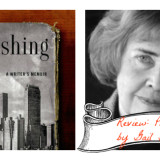
Review: Publishing by Gail Godwin
Positives
Negatives
I had only heard of one Gail Godwin novel – Flora, her most recent – before I spotted this memoir on NetGalley. It turns out she’s the author of 14 novels, two short story collections, and a few nonfiction works, and was a finalist for the National Book Award three times.
Publishing: A Writer’s Memoir is a fairly straightforward account of Godwin’s career, with a focus on the specifics of preparing books for publication: securing a publisher, being assigned an editor, and choosing titles and cover art, for starters. Then there’s also a book’s afterlife: its critical reception and sales, any awards won, and publicity efforts including book tours. A true introvert (see our assessment of Susan Cain’s Quiet), Godwin admits that this part is always a challenge for her: “Once I’m in front of an audience I can perform, but when it’s over I collapse in solitude and wonder how I did it.”
 For some reason I had mentally classed Godwin in the school of dirty realism. Instead it sounds like Flora is a mid-twentieth century version of Henry James’s mildly scary ghost story, The Turn of the Screw. A number of Godwin’s novels have had religious themes, featuring priests or nuns as central characters. Perhaps she was a forerunner of Susan Howatch and Jan Karon? Or, with her Southern background (she was born in Alabama and went to college in North Carolina), might she be closer in tone to Daniel Woodrell, Flannery O’Connor, and Thomas Wolfe?
For some reason I had mentally classed Godwin in the school of dirty realism. Instead it sounds like Flora is a mid-twentieth century version of Henry James’s mildly scary ghost story, The Turn of the Screw. A number of Godwin’s novels have had religious themes, featuring priests or nuns as central characters. Perhaps she was a forerunner of Susan Howatch and Jan Karon? Or, with her Southern background (she was born in Alabama and went to college in North Carolina), might she be closer in tone to Daniel Woodrell, Flannery O’Connor, and Thomas Wolfe?
Any life is full of odd surprises, and Godwin’s was no different. This is not a conventional autobiography, however, so sometimes the very events you’d like Godwin to expand on get short shrift. For instance, her mother, Kathleen Krahenbuhl, was also a writer; I would have liked to hear a bit more about her work. When her mother remarried, Godwin gained half-siblings, one of whom was murdered – an incident that inspired her novel A Southern Family. And then there’s this tantalizing passage:
My life after Chapel Hill had been studded with drama: On assignment for a Miami newspaper, I had spent the night in jail with a woman who had murdered her husband and I had flown on a navy plane into the eye of a hurricane. I had been fired by the same newspaper, been married and divorced within the space of five months, sailed to Europe on a freighter, lived in Copenhagen and the Canary Islands, and, for the last two years, in London, where I worked at a glamorous menial government job.
In just this partial paragraph she hints at so many stories that are outside the remit of this book. One can only hope they’ve been explored elsewhere (Godwin has also published two volumes of her journals, entitled The Making of a Writer).
In 1958, when Godwin was a student, publishers still sent talent scouts out to the major universities to look for promising writers. She took along five pages of a novel in progress, only for Knopf to tell her that she wasn’t what they were looking for. (Can you imagine –publishers went searching for the next Great American novelist in the same way that music producers and baseball coaches search for the next hit singer or star player?! It was a whole different world.) Godwin recalls that she “trudged home under the starlit canopy of obscurity.” Luckily, she was not discouraged and went on to attend the Iowa Writers’ Workshop, where she was a student of Kurt Vonnegut and a classmate of John Irving.
 Godwin generally takes a thematic rather than a strictly chronological approach to her material, so you occasionally get phrases like “but I’ll come back to that in such-and-such chapter.” The structure might be an attempt to avoid tedious lists of what happened and what happened next, but there is, unfortunately, still an element of that. My eyes glazed over a bit when reading about one publisher merging with another or various editors being fired and replaced.
Godwin generally takes a thematic rather than a strictly chronological approach to her material, so you occasionally get phrases like “but I’ll come back to that in such-and-such chapter.” The structure might be an attempt to avoid tedious lists of what happened and what happened next, but there is, unfortunately, still an element of that. My eyes glazed over a bit when reading about one publisher merging with another or various editors being fired and replaced.
I most enjoyed the sections where Godwin intersperses details about her writing with vignettes from her personal life – a longtime relationship with a composer and their home in Woodstock, New York. Bibliophiles will also relish hearing about the process of birthing a novel, especially the challenges of choosing titles and cover art. The only time Godwin gave in to a publisher’s demands and changed a novel’s title (from The Red Nun to Unfinished Desires), she lived to regret it – her Catholic girls’ school novel now sounded like romance pulp.
I daresay any reader of this book will come away with a list of at least three or four Godwin books they’d like to try. I hope this pleasant little memoir will have the desired effect of getting an underappreciated novelist some more attention.
